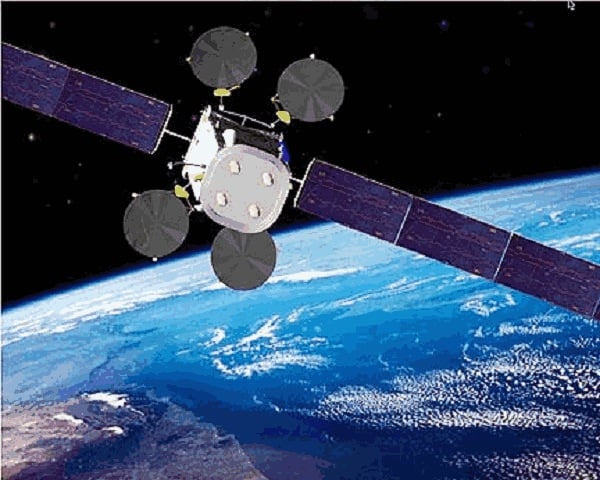
SATELLITE 2020: The Space Force is drafting a new Transformative Acquisition Strategy for buying commercial satellite communications capacity, Clare Grason, the chief of the service’s Commercial Satellite Communications Office (CSCO), told a panel here today.
The new strategy is bouncing off of the new “Vision for Satellite Communications” signed Jan. 23 by Space Command head, and Space Force chief, Gen. Jay Raymond. It’s designed to enable the creation of seamless web of communications capabilities to warfighters, even during conflict.
David Myers, president of Peraton’s Communications sector, told me in an interview that CSCO will likely replace it’s current program, known as the Future Commercial SATCOM Acquisition Program, “with something unique to Space Command that better suits this mission of interoperability between between commercial and government.”
Indeed, Peraton on March 3 announced they had been granted a $218.6 million contract to provide commercial satellite communications services for Africa Command (AFRICOM). According to the company’s March 3 announcement, the “single award, blanket purchase agreement” is a first of its kind, whereby the company “will provide communications services leveraging satellites and emerging technologies from across multiple satellite fleet operators.”
At the same time, Grason told me afterwards, the office is in the process of putting together a funding request for 2022 for a newish, congressionally-mandated program of record to buy commercial satcom directly from operators — although she did not reveal the sum.
“We are POMing against the commercial satcom program of record,” she said. “We’re going through that process right now.”
Congress created the independent program element for commercial satcom within the DoD budget in the 2019, putting $49.5 million into the pot. It added $5 million to the program in 2020, although DoD did not ask for funding. There is no money in the 2021 budget request, Grason explained, although she is working on an unfunded requirements request that might be able to fill that gap.
The program of record, however, will not be used — at least in the near term — to provide satellite communications services to military users in a manner similar to how terrestrial telecom providers like AT&T sell you a data plan for your phone, as a number of commercial satcom operators have been advocating.
Instead, those congressionally appropriated funds would be used “for research and development purposes, to assess capabilities that are emerging,” Grason told me. Once proven, new capabilities might be fed back into the operational program. “Or we could do isolated projects in cooperation with others,” she said. “There’s a lot of flexibility and potential for the arrangement.”
CSCO is leery of crossing the working capital and congressionally appropriated funding streams, Grason explained. “It’s key when it comes down to the program of record that those activities are outside of the scope of our core … transactions,” she told me. “There are legalities there.”
Currently, the CSCO buys commercial satellite bandwidth using a DoD working capital fund — a kind of revolving fund that works a bit like a checking account. CSCO negotiates one-on-one contracts between a satcom provider and a military customer, Grayson said. At any one time, she told the Satellite 2020 audience, the office is negotiating about 30 different deals.
“Our office is responsible for connecting a customer to the marketplace,” she explained.
Under that system, DoD essentially leases commercial bandwidth for short periods of time — an acquisition model that has been widely disparaged by commercial satcom operators. Indeed, Congress in the 2018 National Defense Authorization Act (NDAA) shifted Grason’s office from its original home within the Defense Information Systems Agency (DISA) to Air Force Space Command. That, of course, has now been subsumed by the new Space Force.
The goal of the new acquisition strategy, Grason said, is to streamline that process via a kind of bundling of current contracts with providers.
“We do have a Transformative Acquisition Strategy under development now, that will evolve how we acquire and deliver commercial satcom on an aggregated basis through a smaller number of contracts,” she said, that will “centralize procurement with industry.” CSCO will then turn around and sign so-called ‘service level agreements’ with military customers that, in effect, make them subscribers to commercial services.
“So in essence we’d become like a Direct TV with different cable plans,” she told me, and would managing the relationship between the user and the providers. “It’s a challenging objective, but we believe the benefit lies in the fact that we’re aggregating buying power, we won’t have duplication, we’ll have [broad] coverage, and the ability to shift resources without having to set up new contracts.”
A first draft of which is due at the end of the year, she said.
DoD currently contracts for satcom bandwidth with a number of providers, such as Peraton and Intelsat, which has been vocal in pushing the Pentagon to move to a ‘satellite-as-a-service’ model.
“There’s going to be a very significant change required in the mindset,” Rebecca Cowen-Hirsch, senior vice president for government strategy and policy at Inmarsat Government, told the panel.
But the bulk of DoD’s satcom services and bandwidth comes via the Enhanced Mobile Satellite Services (EMMS) program, for which Iridium Communications was awarded a $738.5 million, seven-year, fixed-price contract in December 2019.
The US military is heavily reliant on commercial satcom, given the fact that military comsat networks, such as the Advanced Extremely High Frequency satellites built by Lockheed Martin and the Wideband Global SATCOM satellites built by Boeing, have limited bandwidth to go around.
In fact, Grason told me, access to milsatcom bandwidth is granted via a “prioritization scheme that customers generally speaking are highly dissatisfied with.”
That said, she admitted that military users of CSCO’s services are naturally a bit skeptical about a new approach.They want to know “how are you going to ensure that the capabilities that we’re getting today are not degraded?” she said. “The linchpin is that the customer will pay for the capability in the form of a service level agreement with us.”
Myer said one model DoD might want to think about is “buying a pool of capacity that gives them portability to move capacity around.” This would it to leverage buying power, he said.
‘The bad day’: DISA’s forthcoming strategy prepares for wartime coms
“It’s great to have internet day to day in peacetime,” said Lt. Gen. Robert Skinner, director of the Defense Information Systems Agency, “but it’s more imperative to have it when bullets are flying.”


























